Mla Mbivu
JF-Expert Member
- Nov 15, 2010
- 224
- 48
MARKTECH
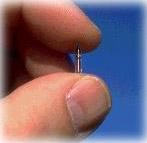
The mark is a microchip assembly which will be implanted under the skin of the right hand. Later on, the mark will be implanted under the forehead, this chip will be used by doctors and hospitals to keep track of medical records, and also will be used as citizen identifier.
How/When it Started
Thurston County Animal Shelter in Washington was the first shelter to begin using the microchips. They began the chip implantation program in 1991. By scanning the area of the microchip insertion, shelters can tell immediately who the owner is of the stray pet they are scanning. The chip sends back a reference number which can be checked in several national databases.
The ID number reveals who the pet's owner is, where the owner lives, the vet performing the service, and the shelter where the animal was implanted with the microchip device. The easiness of identification allows for immediate return of the animal to its owner, eliminating the need for a standard 2 day holding period. Using RFIDs reduces the shelter expenses for holding stray pets.
The ID number reveals who the pet's owner is, where the owner lives, the vet performing the service, and the shelter where the animal was implanted with the microchip device. The easiness of identification allows for immediate return of the animal to its owner, eliminating the need for a standard 2 day holding period. Using RFIDs reduces the shelter expenses for holding stray pets.
How it Works

The RFID implant/VeriChip consists of a microchip, an antenna coil, and a capacitor all enclosed within a sealed glass tube.
Each chip is individually inscribed with a unique identification number during the manufacturing process to ensure that no two RFIDs have the same code number. Each microchip is programmed to store an alphanumeric identification code. The inscribed number identifies the chip by its manufacturer, while the programmed alphanumeric code identifies the animal or human.
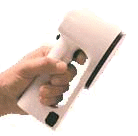
When a scanner is passed over the chip, it sends out low level radio waves which penetrate the inert glass seal and strike the antenna. This creates a small amount of electric current which is stored by the capacitor. The capacitor sends the current to the microchip, which uses the current to access its stored alpha- numeric code. The microchip then sends the code to the antenna, where it will be picked up and read by the scanner. An LCD on the scanning device will then show the ID code. When the number is displayed by the scanner it will be transmitted to an FDA compliant secure data storage site by authorized personnel via telephone or Internet (if used in the USA).
People are being conditioned to accept scanners. Thumb scanners are used to identify customers, so that they do not have to carry a credit card or money. Already in grocery stores like Kroger in Texas, and Thirftway in Seattle, thumb scanners are offered as a convenient alternative to customers. This is to prepare people for the eventual scanning of the mark.
Microchip Manufacturers
There are three major microchip systems in the US.
1. Destron-Fearing Company makes the HomeAgain chip system which is marketed by Schering-Plough Animal Health.
The registration and recovery service is provided by the American Kennel Club. Destron-Fearing also has been known to collaborate with another microchip company AVID.
2. AVID (American Veterinary Identification Devices), and also AVIDCanada make PETtrac. AVID was originally marketed by Identichip Services Recovery System, although now they are almost always partnered with Destron-Fearing.
3. Trovan markets the InfoPET System. They have switched to working with Biomark Inc to track wildlife and fish.
Trovan also markets chips for tracking personal objects.
Size of the RFID Device

The microchip assembly has the size of "a grain of rice". It varies between 1 to 2 cm in length, and about 1/4 cm in diameter (less than one inch in length and 1/8 of an inch in width)
 .
.
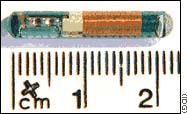
By reducing the size of the components of the RFID it has become possible to insert this device inside the animal or person carrying the implant. The benefits for wildlife is that it cannot be lost. The benefits for future human users is that it will not be able to be disposed quickly by kidnappers as the case with bracelets will be.
Syringes
The syringes that are actually in use for animal implantation in veterinary offices use either liquid or air to push the implant into the site under the skin.
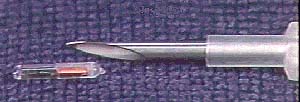
Readers
To be able to read information from the microchip, there are already hand held readers and pocket readers.
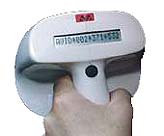
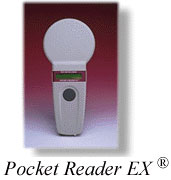
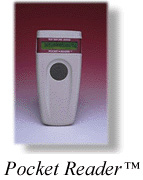
As ascanner is passed over the chip, it sends out low level radio waves which penetrate the inert glass seal and strike the antenna. This creates a small amount of electric current which is stored by the capacitor. The capacitor sends the current to the microchip, which uses the current to access its stored alpha- numeric code. The microchip then sends the code to the antenna, where it will be picked up and read by the scanner. An LCD on the scanning device will then show the ID code.
Human Implantable Devices
To make it palatable for the consumer, the idea of implants has gradually developed. In the same way, the mark of the beast will evolve from a bracelet type device to an implanted device in the hand, and finally to an implanted device in the forehead/brain.
Here are some examples of current implanted devices.
1. Cardiovascular pacers 2. Brainstem implants 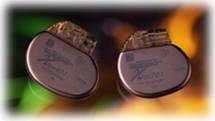
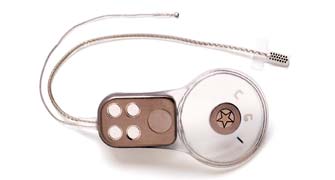
Medtronic Kappa® Pulsenucleus 24 Auditory Brainstem Implant (ABI)
MEMS (Micro Electro-Mechanical System)
The micro-electro mechanical systems device (MEMS) is an implantable micro-sensor that can send data to a hand-held receiver outside the body, alerting doctors to a potential medical crisis, without using any wires or batteries.
Doctors can check the condition of a patient's heart by holding the receiver near the patient. Patients can even monitor their condition at home.
Initial data on the MEMS was presented in January of 2002 at the 14th annual International Symposium on Endovascular Therapy in Miami Beach, Florida.
The MEMS can monitor blood pressure levels in patients with heart failure or with abdominal aortic aneurysm, an abnormal widening of the aorta. If it works, it could provide doctors with an easier way to catch serious problems.
This device is implanted directly in the area under study, such as in an aortic aneurism. The reader device outside the body is the monitor.
By using more implantable medical devices the public becomes desensitized to the idea of more sophisticated technology being implanted inside the body.
4. Brain Pacemaker
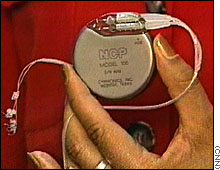
The "Brain Pacemaker"helps prevent epileptic seizures.
The Brain Pacemaker on the right stimulates the brain and helps prevent seizures. This type of pacemaker works by stimulating the vagus nerve. It consists of a pulse transmitter, which looks like a pocket watch, along with proper wiring. It is implanted in the patient's chest and then connected by wire to the left vagus nerve, which runs down the neck and connects the brain stem with the heart, lung and stomach. The pacemaker periodically gives electrical stimulation to the brain to avoid the onset of seizures.
They now want to study this type of implant and examine its use on depressed patients.
About 20% of depressive disorders do not respond to either antidepressants or psychotherapies. Scientists plan to use the pacemaker in this group of patients.
5. Transcrannial Magnetic Stimulation
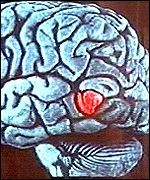
The brain can be stimulated by electric currents
Another method being considered to treat depression is Transcrannial Magnetic Stimulation (TMS).
The patient sits down on a chair and has an octagonal coil of between 10 to 15 centimeters diameter placed on their head.
The coil then carries a current several times per second and generates rapidly pulsating magnetic fields, which stimulate the left forebrain - an area linked to depression
The patient sits down on a chair and has an octagonal coil of between 10 to 15 centimeters diameter placed on their head.
The coil then carries a current several times per second and generates rapidly pulsating magnetic fields, which stimulate the left forebrain - an area linked to depression
Other types of implants approved by the FDA which are inserted inside the body of the patients are: insulin pumps, drug delivery pumps, pain control systems, and nerve stimulators.

RFID/VeriChip in Humans 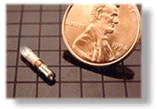
The use of microchips in animals -- now a legal requirement for anyone wanting to ship a cat or dog abroad -- seems fairly harmless. Extending the use to the human population is the next step.
An x-ray of a hand with the implant is included so the reader could
compare the human anatomy.

The RED arrow is pointing to the implant which we believe will be inserted under the skin of the palm by a syringe device specially made for this type of implantation.
compare the human anatomy.
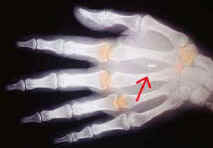
The RED arrow is pointing to the implant which we believe will be inserted under the skin of the palm by a syringe device specially made for this type of implantation.
The availability of implants for use in the human population of the US is no longer the preserve of fiction. One US-based company, Digital Angel, a subsidiary of Applied Digital Solutions (ADS), has already developed the technology for a tracking implanted device to be used in the human population. The makers dwell on the benevolent uses of the device -- such as allowing doctors to monitor medical conditions. Opposition from religious groups, and necessity of FDA approval has delayed the use of the embedded chips.
In December 2001, Digital Angel came out with the VeriChip™. In February 2002 it also applied for the trademarks "get chipped" and "Chipsons" regarding the Florida family, the Jacobs', the first family to be implanted. In June of 2002, ADS was to receive approval for human use of the VeriChip. The chips are being sold in South America where they do not need FDA approval.
"Present Use of the VeriChip™
In South America and Europe, the VeriChip produced by ADSXE is being marketed to identify kidnapped children or adults. Colombia has 3,000 kidnappings per year, the kidnap capital of the world.
The problem of kidnappings continues to get worse and worse. For example, the city of São Paulo, Brazil home to 17 million, had 251 kidnappings in 2001 compared to 39 in 2000, and 13 in 1999.
Cunha Lima, a Brazilian legislator who has served in public office for more than 22 years, said he is excited by the VeriChip's capabilities as a kidnapping deterrent. "I believe this technology will contribute to the public safety and security of Brazilians," he said. "I believe this technology will act to deter the shocking rise of kidnapping in our cities and particularly the abhorrent kidnapping of the children of businessmen."
The makers of the VeriChip promote their product as a universal identification device: "We are promoting VeriChip as a universal means of identification. We expect it to be used in a variety of applications including transportation security, residential and commercial building access, military and government security."
Other Links:
CNN.com - Microchip implants may save lives one day - January 23, 2002
http://www.animal-id.com.au/mchips.html
http://news.zdnet.co.uk/story/0,,s2083914,00.html
http://www.medtronic.com/brady/clinician/medtronicpacing/clinmedt.html
http://www.cochlear.com
CNN - Brain 'pacemaker' may prevent epileptic seizures - August 25, 1999
BBC News | HEALTH | Brain pacemaker to beat depression
Other companies will follow Digital Angel's steps. The chips will become accepted worldwide. The technology, as the reader can see, is already developed. All it needs is public acceptance.
Other companies will follow Digital Angel's steps. The chips will become accepted worldwide. The technology, as the reader can see, is already developed. All it needs is public acceptance.
We Christians know that the return of Jesus/Yeshua our Messiah for the rapture/rescue must be really close. May we all turn to God in our hour of trial and pray for His rescue from the things that are about to develop on this earth.
Do not forget to read Time for the Rescue and may God bless you all with the spirit of understanding.
POST NI NDEFU SANA, LAKINI VYOTE VILIVYOMO NI MUHIMU KUVIFAHAMU AS SIJAONA CHA KUPUNGUZA, NAONA WADAU WANALALAMIKA.
KIFAA HIKI KINAITWA VeriChip NA WATU MBALI MBALI WAMEKUWA WAKITOA MAONI NA KUKIHUSISHA NA CHAPA YA MNYAMA YAANI 666 (MARK OF THE BEAST).
UNAWEZA KU-GOOGLE "VERICHIP" AU CHEKI MAELEZO YAKE HAPA
POST NI NDEFU SANA, LAKINI VYOTE VILIVYOMO NI MUHIMU KUVIFAHAMU AS SIJAONA CHA KUPUNGUZA, NAONA WADAU WANALALAMIKA.
KIFAA HIKI KINAITWA VeriChip NA WATU MBALI MBALI WAMEKUWA WAKITOA MAONI NA KUKIHUSISHA NA CHAPA YA MNYAMA YAANI 666 (MARK OF THE BEAST).
UNAWEZA KU-GOOGLE "VERICHIP" AU CHEKI MAELEZO YAKE HAPA